What to see in Santa Croce Florence. Artworks, chapels and more.
The church of Santa Croce in Florence has a special place in my heart, and in that of many other Florentines. It is a very ancient church, which dates back to the Middle Ages but which has continued to be enriched with works of art over the centuries. And it is also a place that many find deeply spiritual. If you are wondering what to see in the church of Santa Croce in Florence, in this blogpost you will find all the information you are looking for.
Ciao! My name is Claudia, I am a licensed tour guide in Florence with over 10 years of experience. Learn more about me and my private guided tours in Florence. I am also very proud to work as a tour guide for the Opera di Santa Croce, the institution that has been responsible for the protection and development of this place since the 14th century.
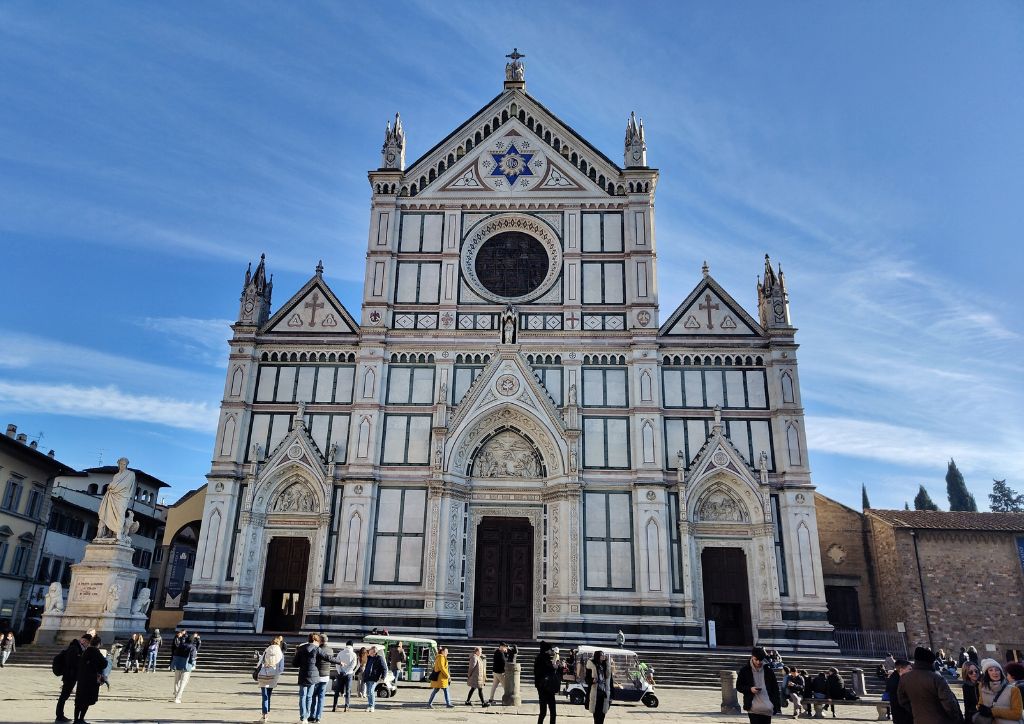
Interesting things about Santa Croce in Florence
Maybe you don’t know that…
- The church of Santa Croce was founded in 1228. But in 1295 it was rebuilt from scratch, much larger than before, and it is the church we can visit today.
- The central nave of the church is 20 meters (22.9 yards) wide and 34 meters (37.2 yards) high.
- Since its foundation in 1228, the church of Santa Croce has been part of a convent of Franciscan friars. The friars still live in the buildings next to the basilica (not accessible to the public).
- Starting from the end of the 1400s, the church became the burial place of the great personalities of Florence. Then, from the mid-1800s, also of some illustrious Italians.
- Some of the richest and most important Florentine families of the past had their chapel in this church. The most beautiful and famous is the Pazzi chapel, designed by Brunelleschi for the family who became famous (and infamous) with the Pazzi Conspiracy.
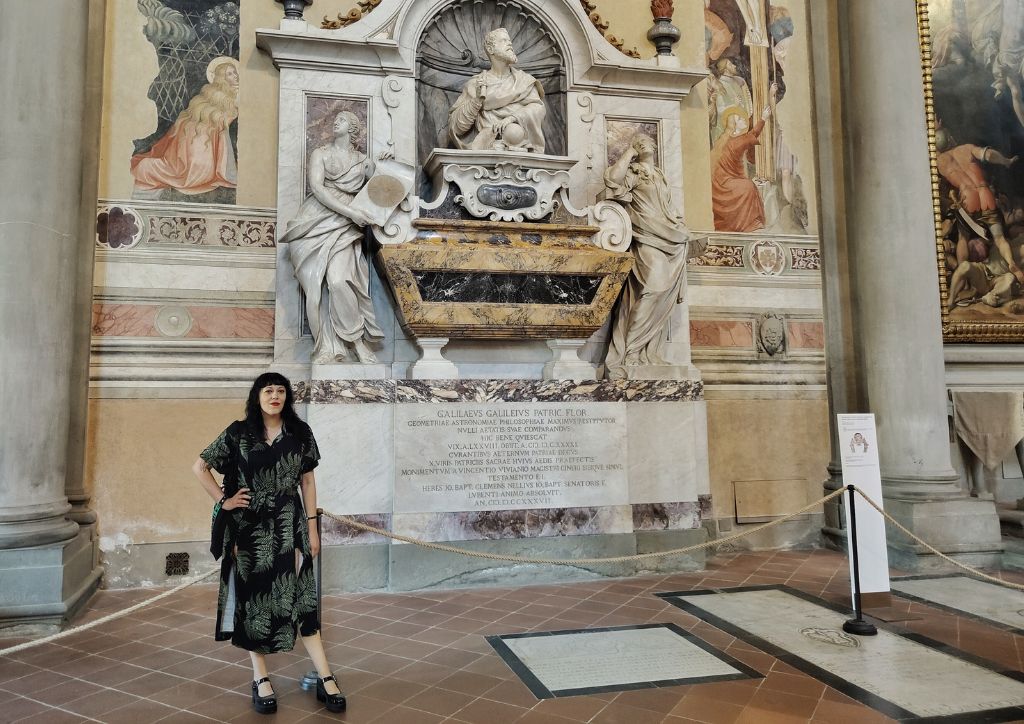
What to see in Santa Croce in Florence
Today the church is part of a complex that also includes the museum of the Opera di Santa Croce, the sacristy and two cloisters. It is a place so rich in history and masterpieces of art, that you’ll have to make a selection of the most important things not to be missed during your visit.
- Allow at least an hour to visit the complex quickly, two hours for a more in-depth visit.
I will list the things not to miss in Santa Croce, Florence, starting from the facade wall, and going towards the altar. Those things are monumental tombs, frescoed chapels, sculptures and paintings.
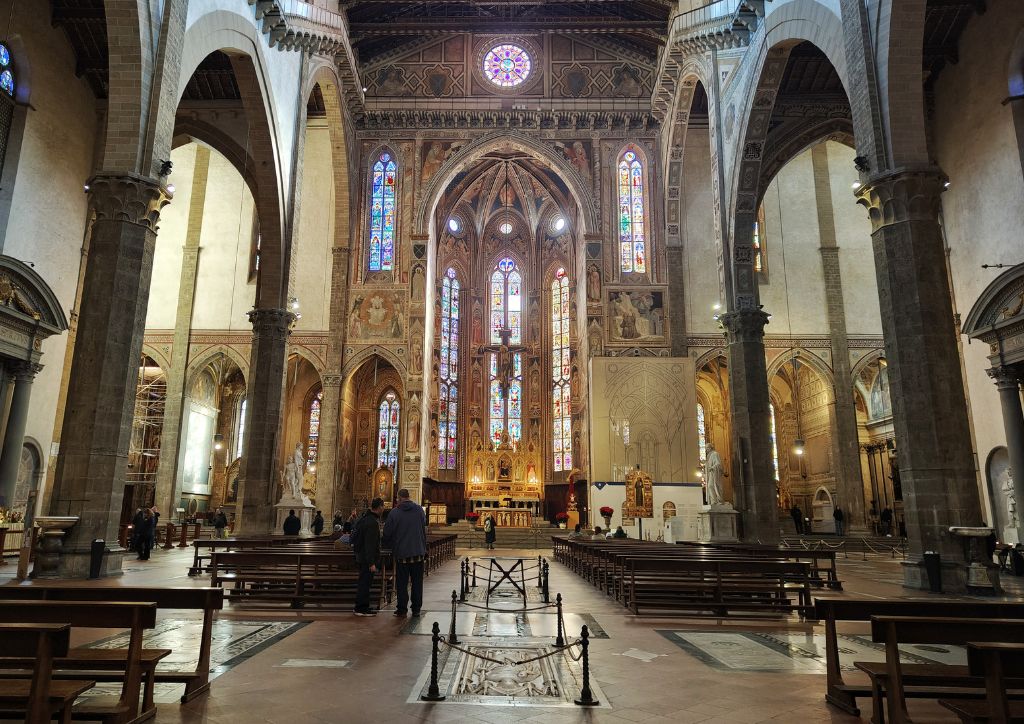
Tomb of Galileo Galilei
The great scientist of the 1600s, accused of heresy by the Catholic Church for his astronomical theories, is buried right here, in a magnificent marble monument. His tomb is decorated with statues representing astronomy and geometry, and the bust of Galileo looking at the sky. In his hand he holds a telescope, one of his most popular inventions.
Giovanni Battista Foggini designed the funerary monument and completed it in 1737. It’s full of symbols celebrating Galileo’s discoveries, such as Jupiter’s satellites. It is the first monument on the left, starting from the counter-façade.
Grave of Michelangelo
Michelangelo Buonarroti died in 1564 at the venerable age of 89 in Rome. However, he was buried in Florence, in the Basilica of Santa Croce, as he wished. The tomb of the great artist is located right in front of that of Galileo Galilei. The two monuments actually resemble each other. Here too there is a bust of Michelangelo, and three female figures representing the arts in which he excelled: painting, sculpture and architecture.
Michelangelo’s tomb was designed by Giorgio Vasari, the statues and frescoes were created by various artists, all members of the Accademia del Disegno.
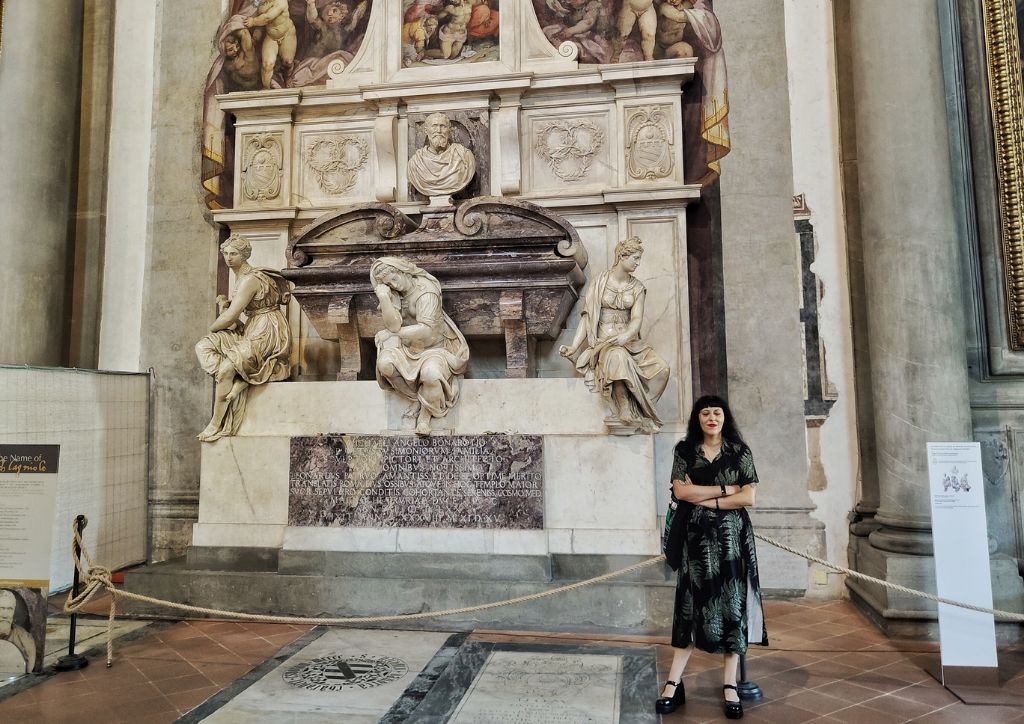
Cenotaph to Dante Alighieri
Dante (yes, the one from Dante’s Inferno) is considered the father of the Italian language and one of the most famous Florentines in the world. This great poet lived in Florence between the XIII and the XIV centuries, but was exiled for political reasons and died in Ravenna (north of the east coast of Italy). So he was buried in Ravenna, and is actually still there.
Florence, after having exiled Dante during his lifetime, would have liked to get him back when he was dead ,and bury him in Santa Croce, together with the other great personalities of the city. Since this was never possible, at the beginning of the 19th century it was decided to build a cenotaph, an empty funerary monument, with a merely symbolic function.
Tombs of Carlo Marsuppini and Leonardo Bruni
You probably don’t know these two names, they were two important political and intellectual figures in Florence in the 1400s. But their graves are two masterpieces of Renaissance sculpture you really shouldn’t miss in the church of Santa Croce.
The two monuments are located opposite each other: that of Leonardo Bruni, sculpted by Bernardo Rossellino in 1450, on the right nave, and that of Carlo Marsuppini, made by Desiderio da Settignano five years later, on the left nave. The two tombs are full of delicate details carved into the marble.
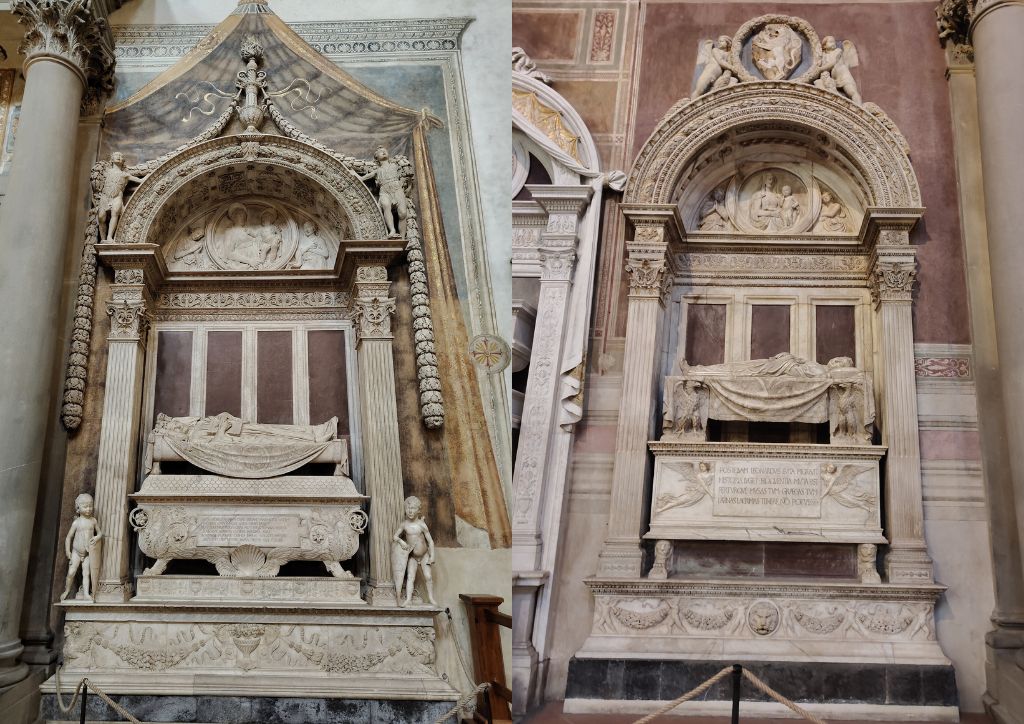
Annunciazione Cavalcanti by Donatello
One of Donatello’s most beautiful and unique sculptures, created in 1435 for the Cavalcanti family when the great artist was at the peak of his long career. It represents the scene of the Annunciation, with the Virgin Mary receiving the visit and message from the angel Gabriel. Instead of using the traditional white marble, so common in the Renaissance, Donatello used the local gray sandstone, called Pietra Serena, and covered it with gold brushstrokes.
The Cavalcanti Annunciation is located on the right nave of the church, next to the door leading to the first cloister.
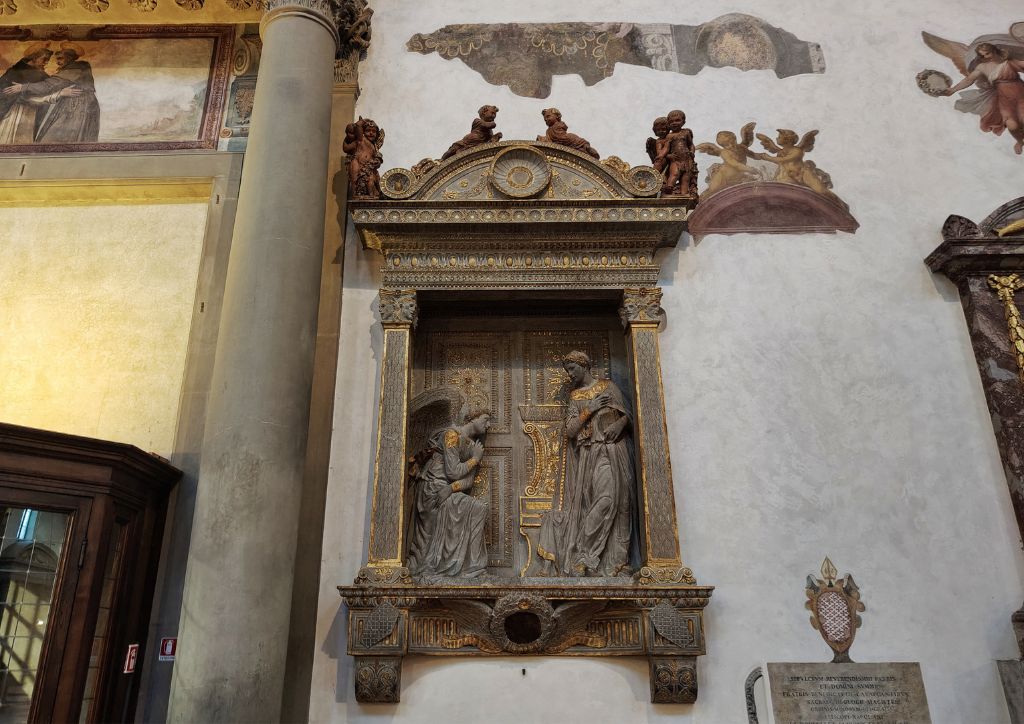
Bardi and Peruzzi chapels by Giotto
Standing in front of the altar, they are the two chapels of the transept right to the right of the main chapel (the one behind the altar).
Giotto painted the Peruzzi chapel around 1310, and about seven years later he also frescoed the nearby Bardi chapel. Both the Bardi and Peruzzi families were very important bankers. The frescoes in the Peruzzi chapel are unfortunately very ruined, but those in the Bardi chapel, with the stories of St. Francis, are just extraordinary, a masterpiece of medieval art.
Note: the Bardi chapel is currently closed for restoration. It should be opened to the public again in autumn 2025.
Donatello’s Santa Croce crucifix
When Donatello created this wooden crucifix, in 1406, he was just twenty years old. According to sources of the time he was harshly criticized by his great friend Brunelleschi. In response to the crucifix of Santa Croce, Brunelleschi sculpted the wooden crucifix of Santa Maria Novella.
Donatello’s crucifix is located inside the Bardi di Vernio chapel. Watch out, it’s not the same chapel with Giotto’s frescoes! Giotto’s one is the Bardi chapel, this is the Bardi di Vernio chapel, which is located at the head of the left arm of the transept. The Bardi di Vernio chapel is usually closed to the public. But one of the Franciscan friars will open it daily (around 3.30pm) for a short visit and a moment of prayer. Anyway, you can still see the crucifix even when the chapel is closed, but from a distance.
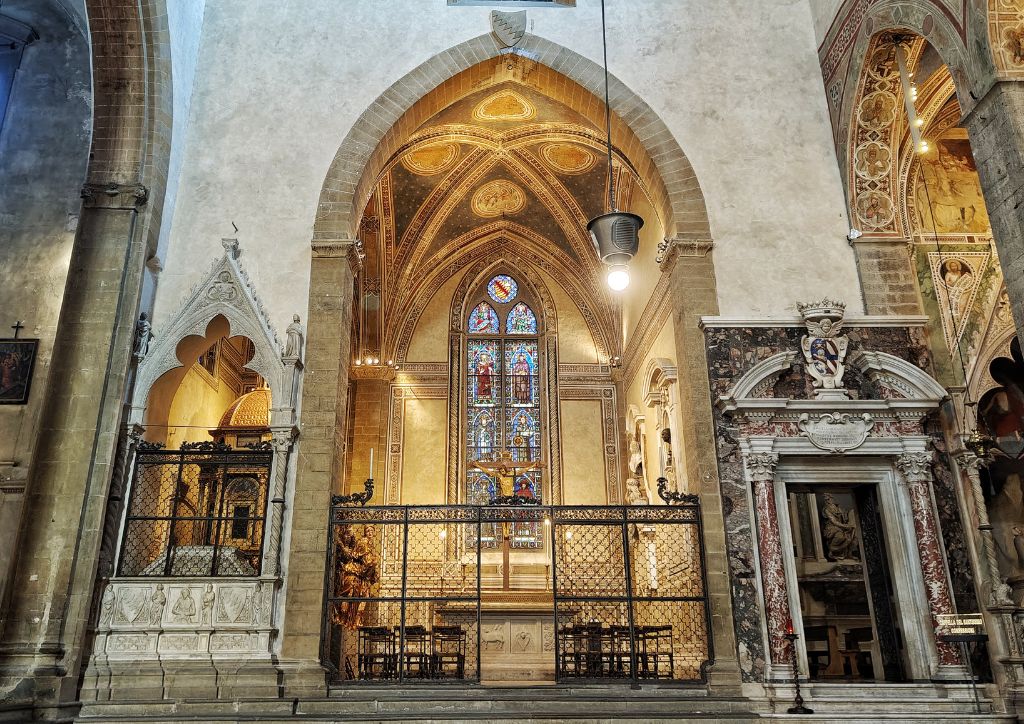
Crucifix by Cimabue
This crucifix was painted by Cimabue (Giotto’s master) around 1265, for the very first church of Santa Croce, before it was rebuilt by Arnolfo di Cambio. It is a masterpiece of medieval painting, the missing link between the idealized Byzantine art and the realistic one of Giotto.
Unfortunately, the terrible flood of 1966 heavily damaged this artwork: it destroyed 60% of the painting. It took over ten years of restoration to save what was left of it. Today it’s safely hung inside the sacristy of the basilica, which is decorated with 14th century frescoes.
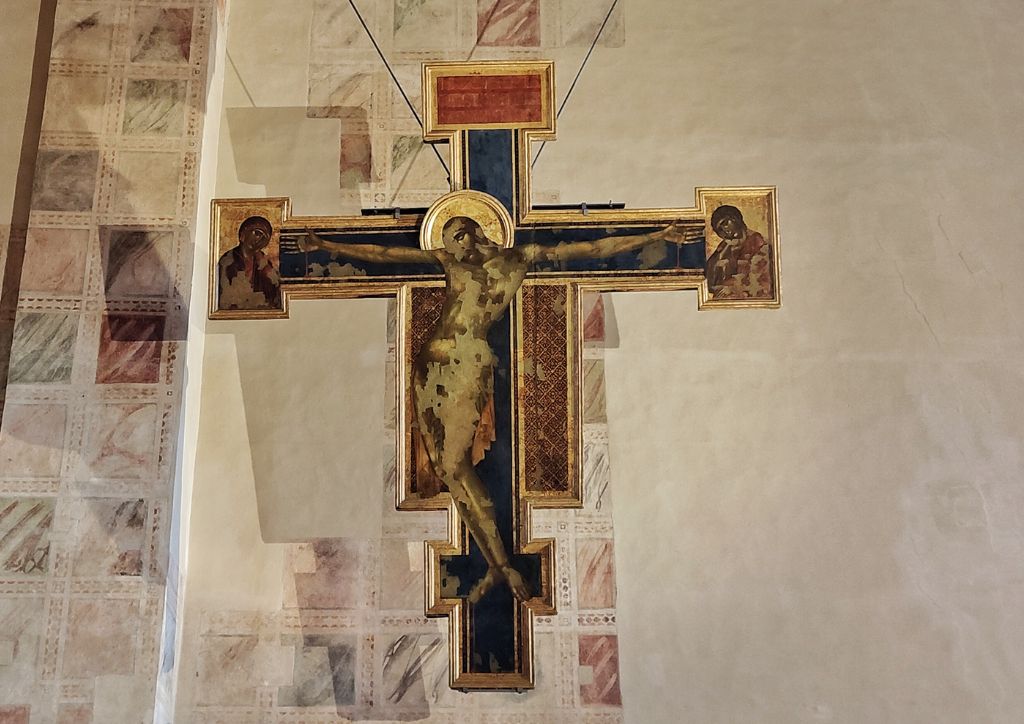
Pazzi Chapel
The Pazzi chapel was built at the beginning of the 15th century at the behest of the rich and powerful Pazzi family. Yes, they are the same ones who later organized the infamous Pazzi Conspiracy. And they had their chapel designed by the greatest architect of those years, Filippo Brunelleschi. In the following years the chapel was enriched with an external portico and gorgeous decorations in tin glazed terracotta by Andrea Della Robbia.
The Pazzi chapel is a masterpiece of Renaissance architecture, one of Brunelleschi’s most representative works, and curiously has many things in common with the Old Sacristy of San Lorenzo, also designed by Brunelleschi for the Medici, the Pazzi’s greatest rivals (learn more about the Old Sacristy in my blogpost about the Medici Chapels and San Lorenzo).
Access to the Pazzi Chapel is located in the first cloister, just beyond the exit of the church.
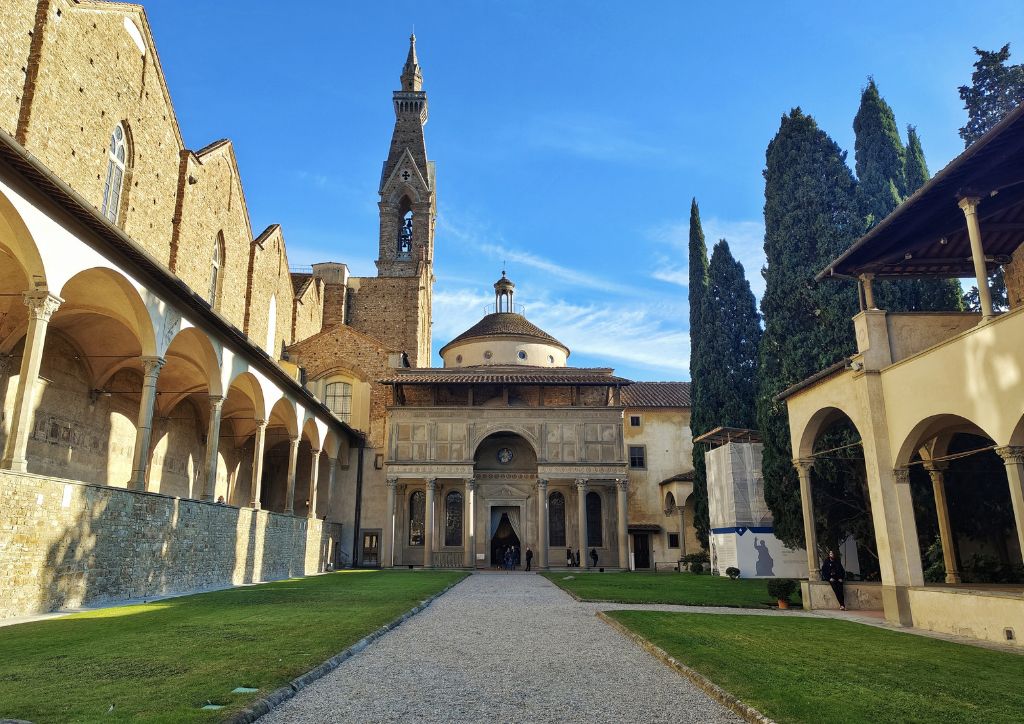
Plan your visit to Santa Croce in Florence
The church of Santa Croce is open every day (except Christmas) from 9.30 to 17.30, and on Sundays from 12.30 to 17.45.
The full entrance ticket costs 8 euros, children under 11 enter for free, and there are many discounts for teenagers, families and students. On the official website of Opera di Santa Croce you can check the fares and also book your tickets in advance. I recommend booking tickets online only in high season.
There are many days with free entry:
- January 1st
- The second Sunday of February
- Easter
- 13 June (feast of Saint Anthony of Padua)
- August 15 (feast of Assumption of Mary)
- September 14 (Feast of the True Cross)
- 4 October (feast of Saint Francis)
- Second Sunday of November
- December 22nd
- December 26th (feast of Saint Stephen).
Have you ever visited this beautiful church? If you have other tips or suggestions about what to see in Santa Croce, Florence, leave a comment and share your favorite artworks!